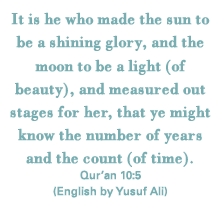
Written by Paul Lunde
The Hijri calendar
In 638 ce, six years after the death of the Prophet Muhammad, Islam’s second caliph, ‘Umar, recognized the necessity of a calendar to govern the affairs of Muslims. This was first of all a practical matter. Correspondence with military and civilian officials in the newly conquered lands had to be dated. But Persia used a different calendar from Syria, and Egypt used yet another. Each of these calendars had a different starting point, or epoch. The Sasanids, the ruling dynasty of Persia, used June 16, 632 ce, the date of the accession of the last Sasanid monarch, Yazdagird iii. Syria, which until the Muslim conquest was part of the Byzantine Empire, used a form of the Roman “Julian” calendar, with an epoch of October 1, 312 bce. Egypt used the Coptic calendar, with an epoch of August 29, 284 ce. Although all were solar calendars, and hence geared to the seasons and containing 365 days, each also had a different system for periodically adding days to compensate for the fact that the true length of the solar year is not 365 but 365.2422 days.
In pre-Islamic Arabia, various other systems of measuring time had been used. In South Arabia, some calendars apparently were lunar, while others were lunisolar, using months based on the phases of the moon but intercalating days outside the lunar cycle to synchronize the calendar with the seasons. On the eve of Islam, the Himyarites appear to have used a calendar based on the Julian form, but with an epoch of 110 bce. In central Arabia, the course of the year was charted by the position of the stars relative to the horizon at sunset or sunrise, dividing the ecliptic into 28 equal parts corresponding to the location of the moon on each successive night of the month. The names of the months in that calendar have continued in the Islamic calendar to this day and would seem to indicate that, before Islam, some sort of lunisolar calendar was in use, though it is not known to have had an epoch other than memorable local events.
There were two other reasons ‘Umar rejected existing solar calendars. The Qur’an, in Chapter 10, Verse 5, states that time should be reckoned by the moon. Not only that, calendars used by the Persians, Syrians and Egyptians were identified with other religions and cultures. He therefore decided to create a calendar specifically for the Muslim community. It would be lunar, and it would have 12 months, each with 29 or 30 days.
This gives the lunar year 354 days, 11 days fewer than the solar year. ‘Umar chose as the epoch for the new Muslim calendar the year of the hijra, the emigration of the Prophet Muhammad from Makkah to Madinah, where Muslims first attained religious and political autonomy. The hijri epoch thus began on 1 Muharram of the year 1 according to the Islamic calendar, which corresponds to July 16, 622 ce, on the Gregorian calendar. Today in the West, it is customary, when writing hijri dates, to use the abbreviation ah, which stands for the Latin anno hegirae, “year of the hijra.”
Because the Islamic lunar calendar is 11 days shorter than the solar, it is therefore not synchronized to the seasons. Its festivals, which fall on the same days of the same lunar months each year, make the round of the seasons every 33 solar years. This 11-day difference between the lunar and the solar year accounts for the difficulty of converting dates from one system to the other.
The Gregorian calendar
The early calendar of the Roman Empire was lunisolar, containing 355 days divided into 12 months beginning on January 1. To keep it more or less in accord with the actual solar year, a month was added every two years. The system for doing so was complex, and cumulative errors gradually misaligned it with the seasons. By 46 bce, it was some three months out of alignment, and Julius Caesar oversaw its reform. Consulting Greek astronomers in Alexandria, he created a solar calendar in which one day was added to February every fourth year, effectively compensating for the solar year’s length of 365.2422 days. This Julian calendar was used throughout Europe until 1582 ce.

In the Middle Ages, the Christian liturgical calendar was grafted onto the Julian one, and the computation of lunar festivals like Easter, which falls on the first Sunday after the first full moon after the spring equinox, exercised some of the best minds in Christendom. The use of the epoch 1 ce dates from the sixth century, but did not become common until the 10th.
The Julian year was nonetheless 11 minutes and 14 seconds too long. By the early 16th century, due to the accumulated error, the spring equinox was falling on March 11 rather than where it should, on March 21. Copernicus, Christophorus Clavius and the physician Aloysius Lilius provided the calculations, and in 1582 Pope Gregory xiii ordered that Thursday, October 4, 1582, would be followed by Friday, October 15, 1582. Most Catholic countries accepted the new “Gregorian” calendar, but it was not adopted in England and the Americas until the 18th century. Its use is now almost universal worldwide. The Gregorian year is nonetheless 25.96 seconds ahead of the solar year, which by the year 4909 will add up to an extra day.